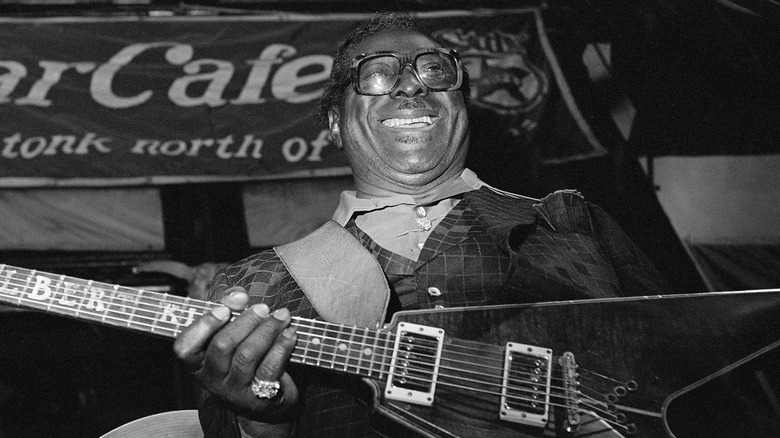How Albert King's Unique Guitar Playing Quirk Influenced The Greatest Musicians Of All Time
In the world of blues music, there are Three Kings: Freddie King, B.B. King, and Albert King. Same names aside, each of them had a drastically different style that added something to blues music. Freddie King was the youngest of the three and hailed from Gilmer, Texas, one part of the equation that led to his nickname, the Texas Cannonball. The Cannonball part of the name stemmed from his propensity for unleashing a fast slew of notes. According to Gibson, Freddie King once got shot down by Chess Records because they thought he sounded too much like another one of the Three Kings: B.B. King.
B.B. King is easily the most well-known of the three, and despite how Chess Records felt about it, his style differed significantly from Freddie King. While Freddie was known for unleashing speedy licks, B.B. was known for his smooth, soulful, deliberate phrasing. His call-and-response style, which he got from gospel music, became his musical signature, which he played on his signature guitar, a lightly modified Gibson Es-355 named Lucille.
The last of the three was the oldest, Albert King. According to Riff Journal, one of his unique abilities stemmed from a mastery of one of blues guitar's basic techniques: bending.
Albert King was a unique brand of bluesman
Left-handed guitars are a somewhat recent development, and many guitar models today are only available in right-handed models. This has caused lefties over the years to take matters into their own hands by taking a right-handed guitar and restringing it for a lefty. The result is an upside-down right-handed guitar. Perhaps the most famous instance of this is Jimi Hendrix's upside-down Fender Stratocaster. Eric Gale, one of the top modern blues players, doesn't even restring his guitar for a lefty, instead opting to keep the bass strings at the bottom of the fretboard (via Roadie Music).
Albert King was a left-handed player who also played with the strings "upside-down." He became one of the early adopters of Gibson's radically-shaped ax, the Flying V. While it's a rock and metal icon today, according to Guitar.com, at first it was a bit of a failure as far as sales. King wound up with one.
Albert King gets the bends
Albert King's guitar was one of the reasons for his legendary bending technique, as the different positions of the strings across the fretboard — bass strings at the bottom, treble strings up top — made his sound hard to replicate. Another factor was how he tuned his guitar. According to Riff Journal, King tuned his guitar one-and-a-half steps lower than standard tuning. This means that each string was three notes lower than in standard tuning, and by tuning so low, the strings had more slack in them. This allowed King to bend more aggressively.
King's set-up is highly unorthodox, which means replicating his sound and playing style is extremely difficult, if not impossible, for the average player. Bending like this was massively important to King's sound and style. He was also known to use double bends, where two strings are bent at the same time, and prebends, which is where a player bends a string before playing it.


